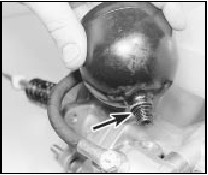Hydraulic unit accumulator (ABS) - removal and refitting
Note: A new O-ring must be used between the accumulator and the hydraulic unit on refitting.
Caution: Refer to the
precautions in Section 1.
Removal
1 Disconnect the battery negative lead.
2 Depressurise the hydraulic system by pumping the brake pedal at least 20 times, or until it becomes hard.
3 Wrap a clean rag round the base of the accumulator to catch any spilt fluid.
4 Unscrew the accumulator using a hexagon key. Remove the accumulator, noting the sealing ring and being prepared for fluid spillage (see illustration). If fluid is accidentally spilt on the paintwork, wash off immediately with cold water.

17.4 Unscrew the accumulator and remove it, noting the O-ring (arrowed)
Refitting
5 Fit a new O-ring to the base of the
accumulator, fit the accumulator and tighten
it.
6 Reconnect the battery. Switch on the ignition and check that the hydraulic unit pump stops within 60 seconds; if not, the accumulator is likely to be faulty.
7 On completion, bleed the complete hydraulic system and check for leaks around all disturbed components.
See also:
Steering wheel - removal and refitting
Removal
1 Set the front wheels in the straight-ahead
position.
2 Prise the trim insert from the centre of the
steering wheel, and where applicable,
disconnect the horn electrical lead(s) (see
il ...
Steering intermediate shaft and flexible coupling - removal and refitting
Removal
1 Apply the handbrake, jack up the front of
the vehicle and support on axle stands.
2 Working in the engine compartment,
unscrew the bolt securing the intermediate
shaft to the inner colu ...
Exhaust manifold - removal and refitting
Removal
1 Disconnect the battery negative lead.
2 Remove the air cleaner and pull the hot air
pick-up pipe from the exhaust manifold hot air
shroud.
3 Remove the securing screws (1 screw on
DOHC ...
